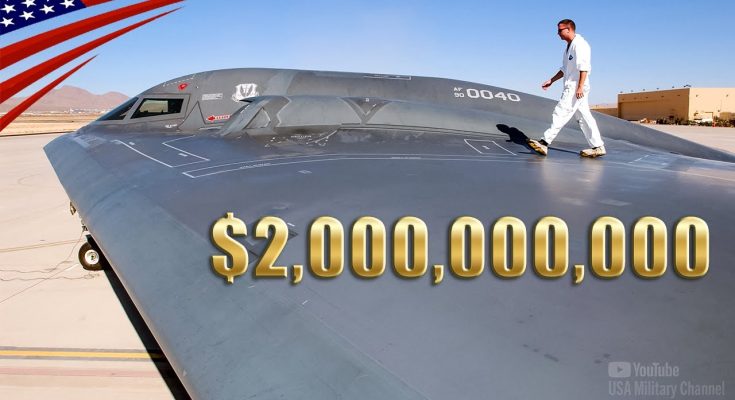he B-2 Spirit, also known as the Stealth Bomber, is one of the most advanced and formidable aircraft in the U.S. Air Force’s fleet. Costing around $2 billion per unit, this flying wing represents a technological marvel, designed to penetrate enemy defenses and deliver nuclear or conventional payloads with unmatched stealth. However, the B-2’s complex design and advanced technologies come with significant maintenance challenges, and keeping these aircraft in top condition requires meticulous attention, highly specialized expertise, and substantial resources.
The Complexities of Stealth Technology
The B-2’s most remarkable feature is its stealth capability, which makes it nearly invisible to radar. This is achieved through the aircraft’s unique flying wing design, which minimizes its radar cross-section (RCS) by avoiding right angles and sharp edges that would reflect radar waves. In addition, the B-2 is coated with special radar-absorbing materials that help it evade detection.
However, this stealth technology comes with a hefty price tag in terms of maintenance and upkeep. The radar-absorbent material (RAM) used on the B-2 is susceptible to damage from environmental factors, including rain, temperature fluctuations, and routine wear. To maintain the aircraft’s stealth capabilities, maintenance crews must perform regular inspections and touch-ups to ensure that the coating remains intact and effective. Even minor damage to the coating can significantly impact the aircraft’s radar signature, making its repair a high-priority task.
Highly Specialized Maintenance Teams
Maintaining a fleet of B-2s requires a highly trained and specialized workforce. The maintenance process involves a combination of scheduled inspections, troubleshooting, and repair work that must be performed with great care. Personnel at the Whiteman Air Force Base, where the B-2 is primarily stationed, undergo extensive training to handle the aircraft’s intricate systems. These systems include advanced avionics, radar, weapons control, and propulsion, all of which require expertise to ensure the aircraft operates optimally.
The aircraft’s complex stealth coatings also demand regular attention from a specific group of materials engineers who are skilled in the restoration and application of radar-absorbing materials. Additionally, because of the sensitive nature of the B-2’s low observability technology, the maintenance of these coatings is conducted under controlled conditions to prevent the aircraft from becoming compromised in any way.
Inspection and Overhaul
In addition to the external coatings, the B-2’s internal systems also require frequent maintenance. For example, the aircraft’s engine pods are designed for low observability and must be regularly inspected to ensure that they remain functional while preserving the aircraft’s stealth properties. The bomber uses four turbofan engines, and maintenance involves checking engine health, replacing parts as needed, and ensuring that the engines are operating efficiently to provide maximum thrust and fuel efficiency.
Because of the B-2’s flying wing design, much of the aircraft’s internal structure is different from conventional aircraft, requiring specialized tools and techniques for any necessary repairs. For example, the airframe’s design means that there are few straight edges, making it more difficult for maintenance personnel to access some components. As a result, maintaining the aircraft often takes longer and requires more detailed inspection protocols than typical aircraft.
Cost and Operational Impact
The costs associated with maintaining the B-2 fleet are substantial, and it’s no secret that the bomber’s maintenance program has been a point of concern for the U.S. Air Force. In recent years, the per-flight hour maintenance cost of the B-2 has been high, with the figure running in the hundreds of thousands of dollars. This expense can be attributed to the specialized personnel required to maintain the aircraft, the high cost of parts and materials, and the rigorous procedures needed to ensure the bomber’s stealth capabilities are preserved.
Despite these challenges, the B-2 has proven its value, especially during its combat deployments, where its ability to evade detection has made it a crucial asset in strategic bombing missions. Its ability to deliver precision strikes from high altitudes—without being detected—has made it a force multiplier in the U.S. military’s arsenal. However, as the fleet ages and the aircraft’s technology becomes increasingly outdated compared to newer stealth platforms like the B-21 Raider, the U.S. Air Force is facing the delicate balancing act of maintaining the B-2 while preparing for the future of long-range strike capabilities.
Conclusion
Maintaining the B-2 Spirit is no easy feat. With its cutting-edge stealth technology, highly specialized systems, and complex design, the aircraft requires extensive and costly upkeep to ensure it remains operational. However, the B-2’s ability to provide strategic, undetectable strike capabilities remains unmatched, making its maintenance a critical investment for the U.S. Air Force. As the U.S. military continues to focus on modernizing its capabilities, the B-2 will continue to serve as a potent reminder of the complex and costly nature of next-generation warfare. Whether the B-2 will be eventually replaced by the more advanced B-21 Raider or remain in service longer is still to be determined, but its legacy and maintenance challenges will undoubtedly have a lasting impact on the future of stealth aviation.



